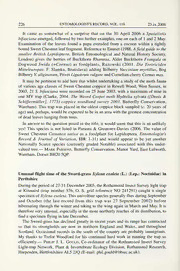
Unusual flight time of the Sword-grass Xylena exoleta (L.) (Lep.: Noctuidae) in Perthshire PDF
Preview Unusual flight time of the Sword-grass Xylena exoleta (L.) (Lep.: Noctuidae) in Perthshire
226 ENTOMOLOGIST'SRECORD,VOL. 118 25.ix.2006 It came as somewhat of a surprise that on the 30 April 2006 a Spatalistis bifasciana emerged, followed by two furtherexamples, one on each of 1 and 2 May. Examination of the leaves found a pupa extruded from a cocoon within a tightly bound SweetChestnut leaffragment. Referenceto Emmet(1988.Afieldguide to the smaller British Lepidoptera. British Entomological and Natural History Society, London) gives the berries of Buckthorn Rhamnus, Alder Buckthorn Frangula or Dogwood Swida (=Cornus as foodplants, Razowski (2001. Die Tortriciden ) Mitteleuropas. F. Slamka, Bratislava) adding Bilberry Vaccinium myrtillus, Bog Bilberry V. uliginosum PrivetLigustrum vulgare andCornelian-cherry Cornusmas. , It may be pertinent to add here that whilst undertaking a study ofthe moth fauna ofvarious age classes of Sweet Chestnut coppice in Rewell Wood, West Sussex, in 2003, 21 S. bifasciana were recorded on 25 June 2003, with a maximum ofnine in one MV trap (Clarke, 2004. The Waved Carpet moth Hydrelia sylvata ([Denis & Schiffermiiller], 1775) coppice woodland survey 2003. Butterfly Conservation, Wareham). This trap was placed in the oldest coppice block sampled (c. 20 years of age) and, perhaps, would beexpectedto be in an area with the greatestconcentration ofdeadleaveshanging fromtrees. In answer to the question posed in the title, it would seem that this is an unlikely yes! This species is not listed in Parsons & Greatorex-Davies (2006. The value of Sweet Chestnut Castanea sativa as a foodplant for Lepidoptera. Entomologist's Record & Journal of Variation, 118: 1-11) and would appear to be yet another Nationally —Scarce species (currently graded Notable) associated with this under- valued tree. Mark Parsons, Butterfly Conservation, Manor Yard, East Lulworth, Wareham, DorsetBH205QP. Unusual flight time ofthe Sword-grass Xylena exoleta (L.) (Lep.: Noctuidae) in Perthshire During the period of27-31 December2005, the Rothamsted Insect Survey light trap at Kinnaird (trap number 576, O. S. grid reference NO 241291) caught a single specimen ofXylenaexoleta. Thisunivoltine species generally flies during September and October (the last record from this trap was 27 September 2002) before hibernating through the winter and taking to the wing again in March and May. It is therefore very unusual, especially in the more northerly reaches ofits distribution, to find aspecimen flying inlateDecember. The Sword-grass has declined greatly in recent years and its range has contracted so that its strongholds are now in northern England and Wales, and throughout Scotland. Occasional records in the south of the country are probably immigrants. My thanks—to Trefor Woodford for his continued hard work in running the trap so efficiently. Philip J. L. Gould, Co-ordinator of the Rothamsted Insect Survey Light-trap Network, Plant & Invertebrate Ecology Division, Rothamsted Research, Harpenden, HertfordshireAL5 2JQ (E-mail: [email protected]).
